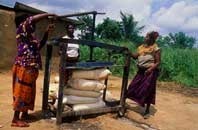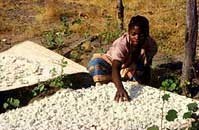CASSAVA’S CYANIDE-PRODUCING ABILITIES CAN CAUSE NEUROPATHY “But these cyanogen-free plants represent a safer and more marketable food product as well as a tool to determine the role of cyanogens in protection against insect pests and crop productivity.”
Sayre and Siritunga engineered cassava plants in which the expression of the genes responsible for linamarin synthesis was blocked. They then analyzed the linamarin content in these plants’ leaves and roots, finding a significant reduction of the cyanogen in leaves (by 60 to 94 percent) and in roots (by 99 percent) compared to normal cassava plants.
Cassava leaves contain more linamarin than do the plant’s roots, Sayre said. Plant biologists believe that somehow linamarin is transported from the leaves to the roots early in a plant’s life. Turning off the linamarin-inducing genes in cassava leaves might reduce the levels of linamarin in the plant’s roots.
“When leaf linamarin was reduced by 40 percent, the roots contained less than 1 percent of the cyanogen,” Sayre said, adding that it’s critical for the leaves of a growing cassava plant to contain a small amount of linamarin.Women are usually charged with processing the plant, which leaves them susceptible to inhaling cyanide gas.
“Linamarin protects cassava from being eaten by insects or animals,” he said. “Plants with moderate linamarin levels in their leaves and that contain nearly no linamarin in their roots are both protected from herbivores and contain far less of the cyanogen in their roots.”
Cyanide forms when cassava is processed. But the toxin is volatile and is released into the air, rather than remaining in the food. Correct processing methods ensure that the cyanogen content in cassava plants will be within an acceptable range, Sayre said. (The United Nations’ Food and Agriculture Organization has established maximum recommended cyanide levels for foods.)
“In African countries, it’s mostly women and children who are susceptible to cyanide poisoning,” Sayre said. “Women are usually charged with processing the plant, which leaves them susceptible to inhaling cyanide gas. Cyanide can poison a person by either inhalation or ingestion.”
The shelf life of a cassava root is very short once it’s removed from the stem, so there’s an urgency to get the food to market.
 In processing, the cassava plants are first crushed and then dried.
In processing, the cassava plants are first crushed and then dried.
“Roots can turn to mush in less than a week,” Sayre said. “Cassava’s fresh market time is very small, so it has to be processed immediately.”
And that’s where consumers can run into problems -- the rush to get cassava to the market may keep some batches of cassava from being processed properly. Even if the plant is properly processed, exposure to the volatile cyanide can cause health problems in people charged with processing the roots and leaves.
While cassava roots contain less than 10 percent of the linamarin level found in cassava leaves, it’s the long-term exposure to cyanide that presents a threat to humans.
“Linamarin is converted to cyanide when eaten,” Sayre said. “Repeated exposure of low doses of cyanide over time can lead to health problems.
“But these cyanogen-free plants represent a safer and more marketable food product as well as a tool to determine the role of cyanogens in protection against insect pests and crop productivity.”
“However, preliminary studies indicate that linamarin may be important in the transport of nitrogen from cassava leaves to its roots in young plants,” he continued. “Plants producing varying levels of linamarin need to be tested in field trials to determine if the inhibition of linamarin synthesis affects plant yield.”
Written by Holly Wagner,